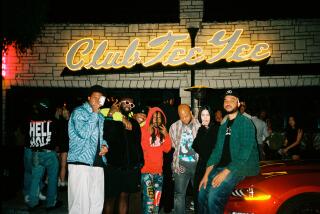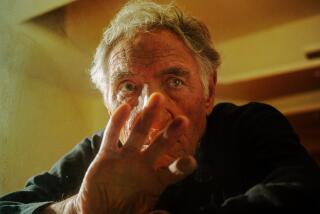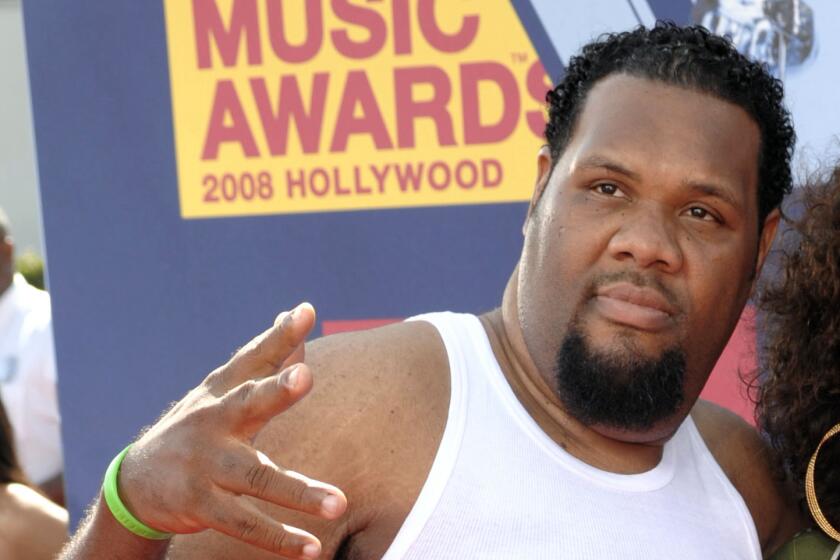Making Sights for Sounds: The Art of Kosh : It all started with ‘Abbey Road.’ In 20 years since, John Kosh has become a living legend with innovative album covers for pop superstars.
No, Paul McCartney wasn’t dead. Yes, Pete Townshend did urinate in public.
Recollections of a lifetime in rock ‘n’ roll. . . . John Kosh sits in his Hollywood studio on a warm Tuesday morning, speaking in a working-class English accent, reminiscing.
Back in the late ‘60s, Kosh was a young Londoner fresh out of art studies at Hornsey College. He was working for the Royal Opera, designing advertisements and looking for something better.
“I got this phone call one afternoon and the voice said, ‘Hello, this is John Lennon,’ ” Kosh said. “I thought, ‘Oh yeah, sure.’ I figured it was one of my friends talking with a Liverpool accent.”
But it really was Lennon, and Kosh found himself enlisted to design a cover for the Beatles’ “Abbey Road” album. The resulting artwork--a simple photograph of John, Paul, George and Ringo walking across the street--has survived as one of pop music’s most memorable images.
In the 20 years since, Kosh has designed covers for Rod Stewart, the Eagles, Jimmy Buffett and 10,000 Maniacs. He made The Who look infamously mischievous. He made Randy Newman look young again. Linda Ronstadt uses him for all her albums, three of which have won Grammys for their artwork.
“He’s amazing,” Ronstadt said. “An album is real personal and so the cover has to be real personal. He understands that. Whatever my fantasy is, he’s good at making it fit into a design.”
At 44, with graying hair and beard, Kosh talks about his job as if it were play, as if he’d crashed some party that won’t seem to end. He never intended to do this sort of work but he’s still at it, having moved from England in 1973 to set up shop amid Los Angeles’ record companies. Kosh talks about his career like a man who won the lottery.
“It’s been a whirlwind,” he said. “I don’t really know how it started or how it happened.”
It started with “Abbey Road” and the rumor that Paul McCartney was dead.
Lennon called on Kosh because he had seen the young artist’s work at the opera. The two men met several times. Yoko Ono was keeping Lennon on a macrobiotic diet and Kosh used to sneak him cookies. Kosh was soon hired by the Beatles.
Meanwhile, reports of McCartney’s demise--which dated to 1966--were continuing to circulate. People said he was killed in a car accident and replaced by a look-alike. The band, reportedly guilty over concealing the death, offered clues on subsequent albums. When the song “I’m So Tired” is played at slow speed, Lennon can be heard mumbling “Paul is dead, miss him, miss him.” At the end of “Strawberry Fields Forever” come words that sound like “I buried Paul.”
The “Abbey Road” cover fueled more rumors. The band was pictured in a funeral-like procession. McCartney was out of step, dressed in black and barefoot. A nearby car bore the license plate “28 IF,” supposedly meaning that he would have been 28 had he survived the 1966 crash.
“It was just a series of coincidences,” Kosh said. “The photo session didn’t take more than an hour or two. We paraded them back and forth across the street and the photographer kept shooting. At what stage Paul lost his shoes, I don’t know. He just took them off at some point.”
Such coincidences may have been staged by the band as part of a running gag. Kosh pleads ignorance to any such plot, though he admits that Apple Records was deliberately vague on the matter and instructed him not to deny any McCartney death rumors.
Fact or fiction, the album sold millions of copies and the commotion brought particular attention to its cover.
By 1971, Kosh followed up with “Let It Be” and The Who’s infamous “Who’s Next.” Again he produced a simple picture--the band standing around a giant concrete block they appeared to have urinated on.
“I’m afraid they did,” Kosh said. “You know how Englishmen drink beer. We were all drinking a lot that day so there was constant urination going on.
“The joke was that the movie ‘2001’ had just come out with that obelisk and we found an obelisk out in the middle of nowhere. It was a piling for a freeway overpass they were building. What better thing to do than go and (urinate) on it?”
Such images linger. They elevated Kosh to lofty status among rock ‘n’ roll musicians and artists.
“He’s a legend, a living legend,” said Tommy Steele, art director for Capitol Records. “He’s one of the guys that, well, we all saw his work as we were coming up.”
Kosh demurs. He says his early photo sessions were guided by whimsy, his technique no more than “wonderful naivete, trying anything and everything.” It was a time, he recalls, when the unpredictable likes of Lennon, Jagger and Moon ruled London’s music scene.
“We were just being outrageous. Everything was going so fast that you didn’t have time to sit back and take notice of what you were doing.”
Beer and naivete notwithstanding, certain formulas govern album design. There are four basic categories: a simple photograph like Carly Simon’s “Playing Possum”; an elaborate set like “Sgt. Pepper’s Lonely Hearts Club Band”; an illustration such as Led Zepplin’s first album; or a logo, as on every Chicago album.
Or, these elements may be combined.
Certain marketing strategies come into play. Some musicians need their faces on the cover to forge an identity with the buying public.
“ELO, for instance, wasn’t a particularly photogenic band,” Kosh said. “They needed a logo.”
The image is the key, and the image must be strong because an average shopper browsing through the racks will glance at a cover for two seconds, industry executives say.
“The record cover should draw the eye,” said Jeff Adamoff, vice president of creative services at MCA Records.
“The bottom line is creating an image,” said Steele, of Capitol Records. “We’re image makers.”
Images are Kosh’s forte, and his reputation has grown steadily with three Grammys and three more nominations. He now works with the help of artists Larry Brooks and Amy Dakos. They have settled in a small studio in Crossroads of the World, an odd office complex on Sunset Boulevard fashioned like a ship.
Musicians and record companies seek out this place, wanting to commission a Kosh cover. The record companies have market-related ideas for the artwork; musicians have their own vision.
“You get very vain musicians who only want their picture on the cover,” Kosh says. “I was hired to do Rod Stewart’s ‘Blondes Have More Fun.’ He wanted to dress up in full Nazi regalia. I didn’t want to do that, so I got my marching orders.”
Ronstadt asks for specific colors on her covers. For the “Get Closer” album, which won a Grammy, she wanted polka-dots and Kosh’s wife, Marjory, found a polka-dot dress for her to wear. Randy Newman brought in childhood photographs to sift through for his “Land of Dreams” album.
Next comes the music. Kosh visits the studio to hear the band. If he can get a tape, he drives with the car stereo playing.
All this preparation leads to brainstorming sessions between Kosh and his co-workers. They may come up with an illustration. They may decide to use the band’s existing logo.
Adamoff recalled the time he was a free-lance artist competing against Kosh for Chicago’s 16th album. He was agonizing over how to use the band’s familiar logo in a fresh way. Kosh--facing the same dilemma--decided to print the logo on a microchip. He then photographed a magnifying glass being held over the chip.
Kosh got the job.
“It was off-the-wall, brilliant,” Adamoff said. “I said, ‘This guy is great.’ ”
Even the simplest cover--a photograph of the band--can be agonizing. Photo sessions drag on for hours. Some musicians are difficult. Others loathe the camera.
“I’d rather dig a ditch,” Ronstadt says.
Kosh has tricks. He sets the studio clock back an hour so the musicians don’t think they have been there so long. With Ronstadt, he plays her favorite Neville Brothers album. With Jimmy Buffett, he keeps up a banter of jokes and a long-running argument over who is younger.
“I’ve always used him because he’s such a pleasure to work with,” Buffett said, “and he’s older than me.”
“Sgt. Pepper’s,” as one of the first high-cost, concept album covers, is credited with acting as a springboard for much of what came after. Suddenly, record companies were willing to spend freely to decorate their products.
The Eagles’ “Hotel California”--designed by Kosh--cost $27,000 for photography alone. For Rod Stewart’s “Foot Loose & Fancy Free,” Kosh built a life-size, watertight hotel room and flooded it.
“We were going to put him on the bed with a pair of shoes floating in the water and masses of steam floating out the bathroom door,” Kosh said. “So the first day, he didn’t show up. The second day, he didn’t show up. The third day, he showed up and said ‘Nah, I don’t like that idea.’ He left me sitting on $10,000 worth of set.”
The cover ended up as a simple photograph of Stewart walking along Mulholland Drive.
A reputation for expense follows Kosh. Set construction and photography for his covers cost anywhere from $5,000 to $15,000 or, on occasion, much more. That is not unusual in the record industry. But, as one of the top names in town, he commands an additional design fee of $5,000 to $15,000 per cover.
Such expenditures are crucial to record companies. Compact discs and cassette tapes, which rule the market, are smaller than albums. Design must compensate for lack of space. In the old days, Kosh might have opted for shock value.
“That law of upsetting mothers--if the mother hates the cover, the kids will buy the album,” he said. “But I’m getting too old to go out and be deliberately offensive anymore.”
He’d rather use an artistic approach. And it occurs to Kosh that he has been pretty successful as an artist. Just about anyone who owns a stereo has some of his work. There are Kosh prints in millions of homes around the world.
“It’s all been by accident,” he said. “I’m just a cockney kid who came around at the right time when London street kids were turning the world upside down.”
More to Read
The biggest entertainment stories
Get our big stories about Hollywood, film, television, music, arts, culture and more right in your inbox as soon as they publish.
You may occasionally receive promotional content from the Los Angeles Times.










